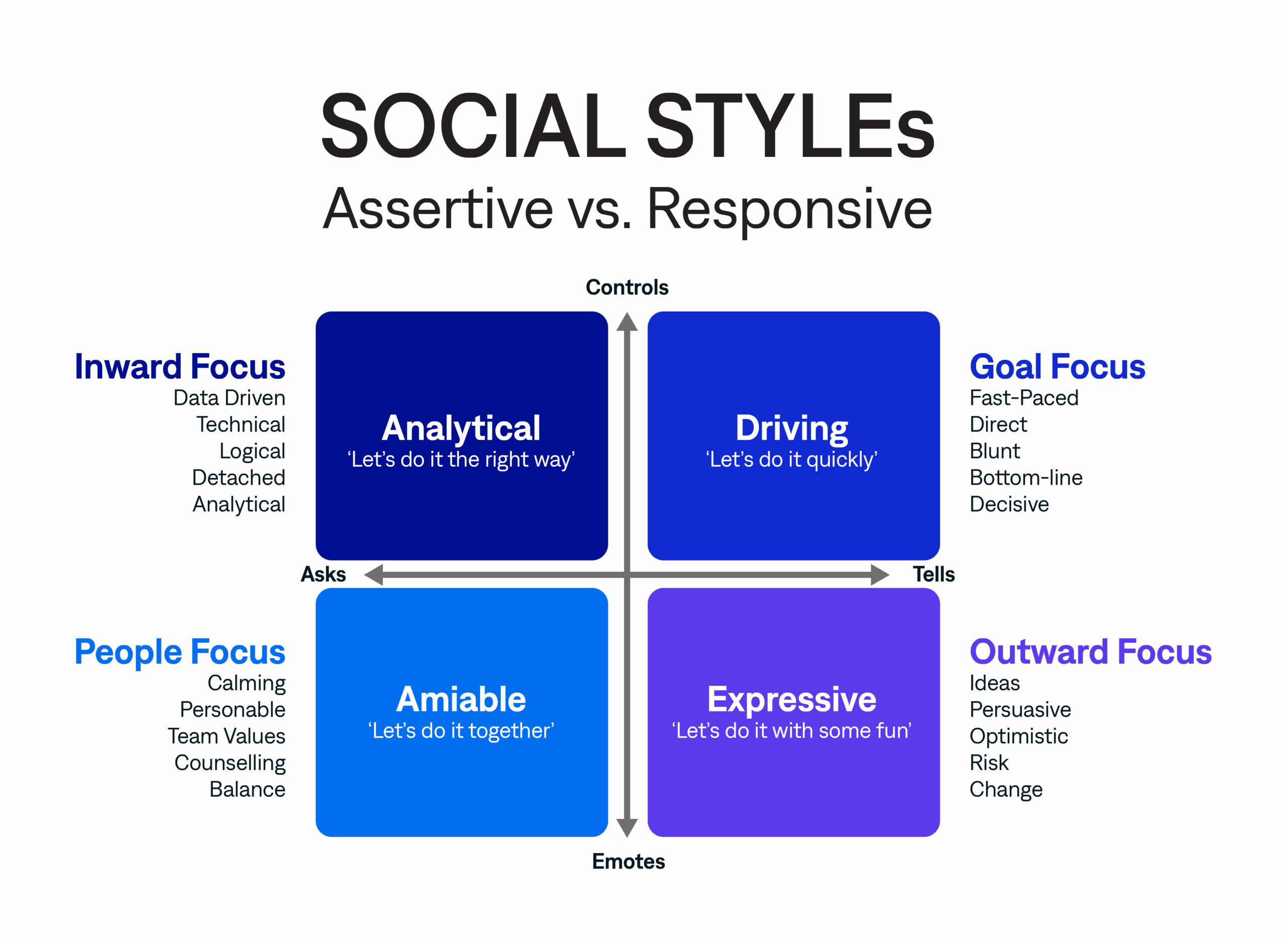
It’s not scientific expertise—it’s the ability to connect. The best insights don’t come from data alone—they come from people. And people respond to how you make them feel, how well you listen, and how clearly you communicate.
That’s why Amplity Learn offers Communications Excellence training—to help medical science liaisons (MSLs) and their managers connect and collaborate more effectively in the field and across teams.
At the heart of our training is the TRACOM SOCIAL STYLE Framework, a widely accepted rubric for understanding you and your teammates’ communication preferences.
The SOCIAL STYLE Model™ is built on a simple idea: we all have a natural communication style—and under pressure, we tend to default to it. And with awareness and practice, we can become more versatile in how we engage with others—making us more effective.
The model breaks behavior into four primary styles—Analytical, Driving, Amiable, and Expressive—based on two key dimensions: assertiveness and responsiveness.

Becoming aware of your default style is the first step. It gives you a clearer sense of how you tend to communicate—and how that might land with others. It helps you respond intentionally instead of just reacting without thinking.
“Knowing you’ll fall back on one quadrant when you’re tired or under pressure helps you flex when it matters most,” explains Mark Bools, a Learning Content Strategist with Amplity’s Learn team.
For example, if you lean toward an Expressive Style, you may lead with energy and storytelling. That enthusiasm can be a strength—but in a high-stakes conversation with a colleague who has an Analytical Style, it might come across as unfocused. Being aware of that difference helps you pause, recalibrate, and communicate in a way that resonates.
It’s important to remember that a SOCIAL STYLEs assessment is not a personality test. It doesn’t explore the why behind behavior. Instead, it focuses on observable behaviors—what others can see in how you show up and communicate.
By reading the cues—tone, pacing, posture, even email style—you can identify someone’s likely communication style and adjust your approach. Subtle shifts in how you speak or frame your message can turn a closed door into an open conversation.
“SOCIAL STYLEs is a bit like a key,” says Bools. “It gives you the little key you can unlock the door with.”
For instance, if you’re meeting with a fast-paced KOL, you might skip small talk and get straight to the facts—mirroring a Driving Style. With a more relational HCP, you may start with a personal connection to build trust before diving into the science. Getting your message across isn’t just about what you say—it’s how well you meet the other person where they are.
For MSLs, the impact of knowing your communication style is immediate and can be measurable. Stronger relationships with KOLs lead to deeper, more actionable insights. Those conversations lead to better data that shape brand and therapeutic strategy. Without real connection, those insights stay surface-level—or don’t emerge at all.
“If you [as an MSL] aren’t capable of having a conversation that gets beyond the surface,” says Bools, “you can’t perform one of the most fundamental aspects of your role.”
Becoming aware of your style is especially valuable when you’re competing for attention in crowded therapeutic areas and have fewer minutes with stakeholders. Every interaction has to count.
Managers can also use communication styles to better coach and support their teams.
To give feedback that resonates, for instance, it helps to understand what motivates each style—and how they prefer to receive information. Here’s a quick guide:
“If you’re coaching someone with an Analytical Style, giving feedback without data probably won’t land,” says Bools. In contrast, a team member with an Expressive Style may respond better to encouragement and energy. Understanding these differences helps leaders deliver guidance that sticks.
Communications training using SOCIAL STYLEs also helps strengthen collaboration—especially for field-based teams that often connect virtually. When team members understand each other’s styles, it’s easier to build trust and rapport.
The SOCIAL STYLEs model promotes a mental shift from automatic reactions to intentional communication. Once you understand your natural style, you can adjust your approach in a thoughtful, consistent way.
“It’s not just about temporarily flexing,” says Bools. “It’s about becoming versatile—like a chameleon who adjusts just enough to connect better.”
Versatility doesn’t mean pretending to be someone you’re not. Rather, the goal is to communicate in a way that connects with others while staying true to your values and purpose.
Communications training equips MSLs and leaders with the tools to build trust, strengthen relationships, and gather insights that drive real impact. “This is a life skill, not just a work skill,” Bools emphasizes, adding that when you adapt to someone else’s style, they often meet you halfway—building mutual trust.
The importance of communication skills continues to grow—especially in complex, cross-functional roles like those in medical affairs. Knowing how to connect, listen, and adapt is now just as critical as clinical knowledge.
That’s why a SOCIAL STYLEs assessment is a core part of Amplity’s Learn Communications Excellence programming. Whether part of a broader capability workshop or a standalone session, it provides the foundation for stronger conversations—and better performance—at every level.